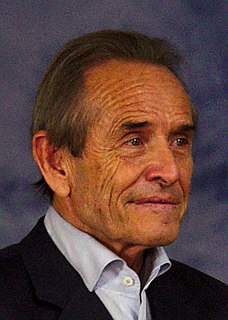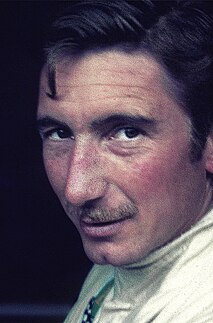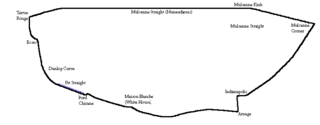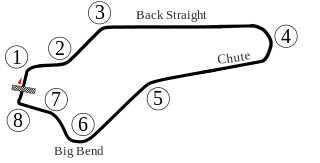
Jacques Bernard "Jacky" Ickx is a Belgian former racing driver who won the 24 Hours of Le Mans six times and achieved eight wins and 25 podium finishes in Formula One. He greatly contributed to several World Championships for Makes and World Sports Car championships: Ford (1968), Ferrari (1972), Porsche (1976–1977) and (1982–1985) by his 37 major World Sports Car wins. He also won the Can-Am Championship in 1979 and the 1983 Paris–Dakar Rally.

The 1971 Italian Grand Prix was a Formula One motor race held at Monza on 5 September 1971. It was race 9 of 11 in both the 1971 World Championship of Drivers and the 1971 International Cup for Formula One Manufacturers.

The 1971 Formula One season was the 25th season of the Fédération Internationale de l'Automobile's Formula One motor racing. It featured the 22nd World Championship of Drivers and the 14th International Cup for F1 Manufacturers which were contested concurrently over eleven races between 6 March and 3 October. The season also included a number of non-championship races open to Formula One cars.

The 1968 Formula One season was the 22nd season of the FIA's Formula One motor racing. It featured the 19th FIA World Championship, which commenced on 1 January, and ended on 3 November after twelve races, and numerous non-championship races. Graham Hill won the second of his World Championship titles, with Lotus.

The Porsche 917 is a sports prototype race car developed by German manufacturer Porsche. The 917 gave Porsche its first overall wins at the 24 Hours of Le Mans in 1970 and 1971. Powered by the Type 912 flat-12 engine of 4.5, 4.9, or 5 liters, the 917/30 Can-Am variant was capable of 0-62 mph (100 km/h) time of 2.3 seconds and 0–124 mph (200 km/h) in 5.3 seconds. The long tail Langheck version had a maximum measured top speed of 386 km/h (240 mph).

Joseph Siffert was a Swiss racing driver.

Ludovico Scarfiotti was a Formula One and sports car driver from Italy. Just prior to entering Formula One, he won the 1963 24 Hours of Le Mans for Ferrari. He later participated in 12 World Championship Formula One grands prix, and many non-championship races. He won one World Championship race, and scored a total of 17 championship points. A motor sports competitor for a decade, Scarfiotti won the 1962 and 1965 European Hillclimb Championship. He was proclaimed Italy's best driver in both 1962 and 1965.

John Wyer, was an English automobile racing engineer and team manager. He is mainly associated with cars running in the light blue and orange livery of his longtime sponsor Gulf Oil.

Ferrari 512 S is the designation for 25 sports cars built in 1969–70, with five-litre 12-cylinder ("512") engines, related to the Ferrari P sports prototypes. The V12-powered cars were entered in the 1970 International Championship for Makes by the factory Scuderia Ferrari and private teams. Later that year, modified versions resembling their main competitor, the Porsche 917, were called Ferrari 512 M. In the 1971 International Championship for Makes, the factory focused on the new Ferrari 312 PB and abandoned the 512 which was only entered by privateers. From 1972 onwards, the 512 was withdrawn from the world championship following a change in the regulations, and some 512s in private hands were entered in CanAm and Interserie races.

The 1971 24 Hours of Le Mans was the 39th Grand Prix of Endurance, and took place on 12 and 13 June 1971. It was the ninth round of the 1971 International Championship for Makes.

The 1970 24 Hours of Le Mans was the 38th Grand Prix of Endurance and took place on 13 and 14 June 1970. It was the 8th stage of the 1970 World Sportscar Championship season.

The 1969 24 Hours of Le Mans was the 37th Grand Prix of Endurance, and took place on 14 and 15 June 1969. It was the eighth round of the 1969 World Sportscar Championship season.

The 1968 24 Hours of Le Mans was the 36th Grand Prix of Endurance, and took place on 28 and 29 September 1968 on the Circuit de la Sarthe, in Le Mans, France.

The 1970 12 Hours of Sebring was an endurance race held at the 5.2 mile (8.3 km) Sebring International Raceway, Sebring, Florida, United States on March 21, 1970. It was the twentieth running of the endurance classic and the second round of the 1970 World Sportscar Championship season.

The 1970 1000 km of Brands Hatch was an endurance race held at the Brands Hatch circuit in Kent, England, United Kingdom on April 12, 1970. The race was the 3rd round of the 1970 World Sportscar Championship season.

The 1970 1000 km of Monza was an endurance race held at the Autodromo Nazionale Monza, Monza, Italy on April 25, 1970. It was the fourth round of the 1970 International Championship for Makes. This was the first official 1000 km race at Monza that used only the road course; in 1956 and 1965-1969 the organizers utilized the combined road and banking courses; but the banking was abandoned because of safety issues; the 1969 1000 km race was the last race ever held on the concrete-surfaced banking. Mexican driver Pedro Rodríguez won this race in John Wyer's Gulf-sponsored Porsche 917K, he was able to hold off 3 hard-charging works Ferrari 512's after his co-driver Leo Kinnunen lost most of the lead Rodríguez had built up. Ex-Ferrari driver John Surtees returned to Ferrari after 4 years to drive a works 512.

The 1970 Targa Florio was an endurance race that took place on 3 May 1970. It was held on a 44.6 mi (71.8 km) anti-clockwise circuit made up entirely of public roads on the mountainous Italian island of Sicily. It was the fifth round of the 1970 International Championship for Makes.

The 1970 1000km of Nürburgring was an endurance race held at the Nürburgring Nordschleife, Nürburg, West Germany on May 31, 1970. It was the seventh round of the 1970 World Sportscar Championship season.

The 1970 Watkins Glen 6 Hours was an endurance race held at the Watkins Glen Grand Prix Race Course, New York, United States on July 11, 1970. It was the ninth round of the 1970 World Sportscar Championship season.

The 1970 Austrian 1000km was an endurance race held at the Österreichring, near Zeltweg, Austria on October 11, 1970. It was the tenth and final round of the 1970 World Sportscar Championship season.
















